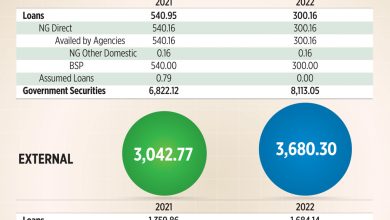Trade deficit widens in March

By Bernadette Therese M. Gadon, Researcher
THE country’s trade-in-goods deficit widened to a three-month high in March as imports outpaced exports which could dampen the economic output in the first quarter.
Preliminary data from the Philippine Statistics Authority (PSA) showed the value of merchandise exports grew by 5.9% to $7.171 billion in March, easing from 15.8% growth in February and 33.4% in March last year.
This was the lowest pickup in five months or since the 2% growth in October 2021.
Meanwhile, the country’s merchandise imports rose by 27.7% to $12.175 billion in March. This was slower than the 28.6% posted the previous month but faster than 22.1% a year ago.
This matched January’s pace and was the lowest in five months or since the 25.2% growth in October last year.
This brought the trade-in-goods deficit to $5.004 billion in March, almost double the $2.759 billion gap a year ago. It was the widest trade gap since December last year’s $5.273 billion shortfall.
In the first quarter, the trade gap further yawned to a $13.892 billion deficit, wider than the $8.345 billion gap registered in the same period last year.
For the three-month period ending March, exports rose by 9.8% year on year to $19.418 billion, already above the 6% growth projected by the Development Budget and Coordination Committee this year.
Meanwhile, imports surpassed the 10% growth projection for 2022 with a 28% increase during the first three months of the year to $33.309 billion.
“The bloating trade deficit should weigh on the overall GDP (gross domestic product) print,” ING Bank N.V. Manila Branch Senior Economist Nicholas Antonio T. Mapa said in an e-mail interview.
“Export growth continues but has finally normalized after base effects wane. Sector continues to take its cue from the performance of the mainstay electronics sector,” he said.
“Imports also posted an expected double-digit gain in large part because of the bloated fuel import bill. However, key subsectors such as consumer imports and capital machinery suggests that the economic recovery will continue to be shallow as consumption and investment momentum is not as robust as hoped for,” Mr. Mapa added.
Historically, exports of goods and services account for around a fourth of the Philippine economy, while imports have more than 30%.
The PSA will report the first-quarter GDP data on May 12.
Electronic products remained the country’s top export product, accounting for 55.3% of total sales in March. Total receipts for this commodity group amounted to $3.963 billion that month, rising by 8.1% from $3.666 billion in March last year.
Semiconductors, which accounted for about three-fourths of electronic products and 41.8% of total exports in March, increased by 9.2% annually to $2.996 billion from $2.744 billion a year ago.
Other mineral products went up by a fifth to $410.857 million, with 5.7% share to total sales that month.
Other manufactured goods, meanwhile, dropped by 4.5% to $375.679 million. It accounted for 5.2% of exports in March.
Raw materials and intermediate goods took a 37.3% share of March’s import bill. Its bill amounted to $4.544 billion in March, higher by 18% annually from $3.851 billion a year ago.
Capital goods went up by 9.5% to $3.270 billion from $2.986 billion. Mineral fuels, lubricant, and related materials more than doubled to $2.584 billion from $1.042 billion.
Importation of consumer goods likewise rose by 8.6% to $1.711 billion.
Danilo C. Lachica, president of the Semiconductor and Electronics Industries in the Philippines, Inc. (SEIPI) attributed March’s trade performance to the lockdowns imposed in China and Hong Kong, as cases of the Omicron variant rose and supplies were put on freeze.
“What’s more bothersome would be the lockdowns in China. Because we get 30% of imported materials from China and Hong Kong, and basically with the lockdowns, it’s impacting the materials and the logistics lead time. So that’s the impact of the pandemic,” he said in a Zoom video call interview.
“In addition to that, if you have supply chain disruption, your costs skyrockets, as it is right now, Philippines has a higher logistics cost than our ASEAN neighbors at something like 20-30%, so it’s exacerbated by these supply chain [issues] because we have to pay premium for deliveries,” he added.
The Russia-Ukraine conflict that started in February also played a part in terms of fuel costs in the latter half of the quarter, Mr. Lachica said. However, the lowering of prices seen at present indicates better trading in the coming months.
China announced country-wide lockdowns across in late March, especially in their main cities after a surge in coronavirus (COVID-19) cases, forcing companies to stop trading and supplies going in and out to be delayed.
Despite this, China remained to be the country’s top source of imports with 17.5% share in March, lower than the 24.1% in the same month last year. This was followed by Japan (10.2%), and South Korea (9.8%).
China was also the top destination of Philippine-made goods, with a 16.5% share of total export sales in March. It was followed by the United States (15.2%) and Japan (14.5%).
For the rest of the year, Mr. Lachica said commodities related to work-from-home setups will drive the trade, and ease of lockdowns in China will pick up the slower growth recorded in March, adding that the Philippines should also continue to control the COVID-19 cases to avoid further disruption of the supply chain and operations locally.
Restrictions in Metro Manila and various parts of the country have been relaxed to Alert Level 1 since March.
“For April’s trade, I guess we’ll probably continue to see an increase in medical electronics, semiconductor components, telecommunications products because of the work-from-home [setups],” Mr. Lachica said.
“The widening trade deficit means pressure on the peso will persist into the medium term and exert more price pressures for the rest of the year and next,” Mr. Mapa said.




